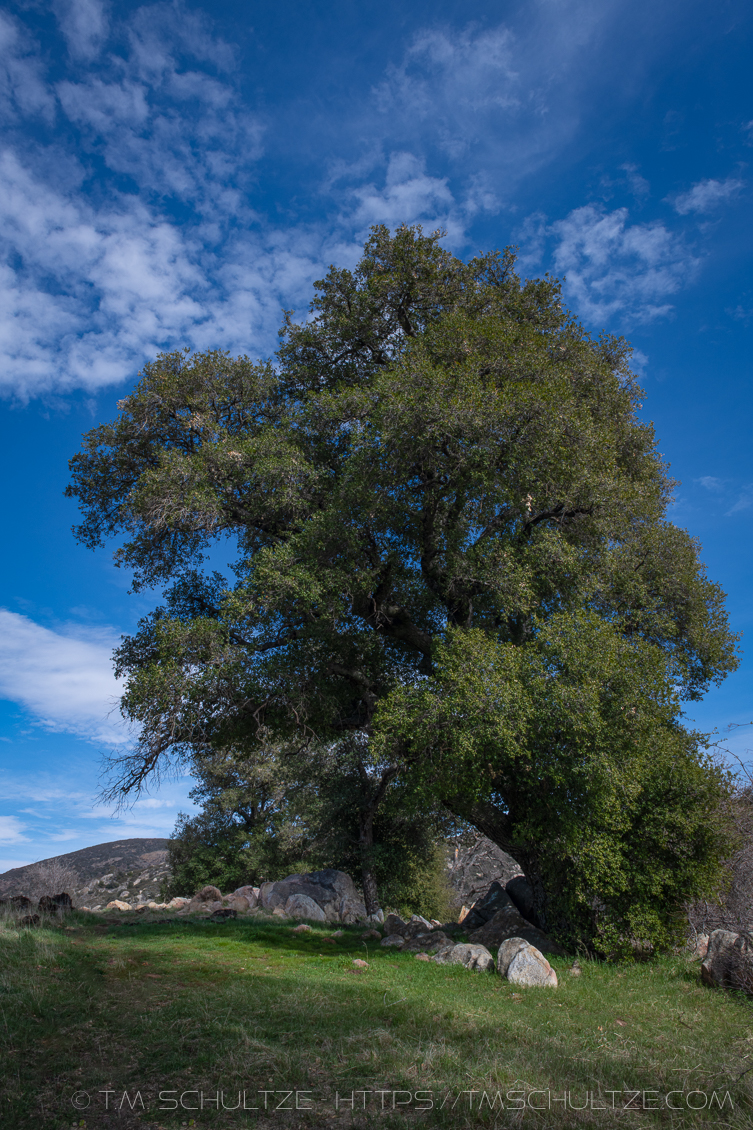My March 2021 Photo of the Month is CR28, a photo of a Coast Live Oak (quercus agrifolia) created in San Diego County’s Cuyamaca Rancho State Park.
CR28 Background
Winter was mild, and Southern California entered Spring mired in drought. Despite a wet 2018 – 2019, this is a long-term arid period for a place known for being dry.
There are wildflowers to be found, sparingly. A couple small storms did arrive. I always expect the rain totals will be half what is forecast. Such is life in drought in a period of accelerated climate change.
Our pine forests are retreating. The bark beetle has culled the weaker stands, leaving plenty of fuel for our all too frequent fires. Stands that used to begin at 4,000 – 5,000 feet are now beginning 1,000 feet higher, and may someday thrive at an elevation that is higher than all but a couple points in San Diego County.
What really gives California its distinctive nature are the stands of beautiful oak forest. The black oaks of the high elevations are sans leaves. The oak from from my November Photo of the Month is sparing and bare.
GPS Scavenger Hunt
One of the underused modules in Lightroom is the Map Module. I use the Nikon GPS-1 that mounts in the camera hot shoe. Over 100,000 images in my Catalog have GPS coordinates. Once you build this, you have a great tool for evaluating where you photograph and looking for “blind spots” that you can overlooked on your photo map.
For me, one of these places is Cuyamaca Rancho State Park. South of Paso Picacho, there are a number of trailheads which are also the only parkable locations along State Route 79. I noticed I really didn’t have any work in the area. On a day with beautiful clouds, I stopped at the Meadow trailhead.
This area is near the beginning of the Sweetwater River further up Upper Green Valley. A small trail leads over a knoll with a stand of oaks. It was coming up this path that I encountered what became CR28. I immediately thought it was a great composition.
Our oak forests are in trouble. The accidental introduction of the Gold Spotted Oak Borer, thought to have occurred in Descanso from imported firewood, has devastated large oak stands. Climate change-inducted long-term drought has weakened these trees. An introduced invasive species that these oaks are not prepared to fend off is a problem. Some stands have lost 90% of their trees.
What struck me was how healthy this tree looked. There were a couple smaller, healthy trees in the stand. Both sides were buttressed by dead and collapsed oaks. I hid them from frame, but with the wider view of our peripheral vision, it is easy to understand how ephemeral it is becoming to see a healthy, non-threatened oak in our chaparral regions.
For one moment, though, I got to appreciate one magestic example in our East County, as well as fill in a “hole” in my Lightroom catalog’s Map Module. Let’s hope these trees, that can live hundreds of years, do not become a threatened species.
As always, thank you for reading, and I hope you enjoy the image.
Further Viewing
Photos of the Month Portfolio Gallery
San Diego’s East County Portfolio Gallery
T.M. Schultze Print-On-Demand Fine Art America Store
T.M. Schultze is a San Diego-based photographer, traveller, and writer. He writes, photographs, and draws things of the outdoors that have inspired humans for thousands of years. He co-authored the Photographer’s Guide to Joshua Tree Park which can be purchased here.
